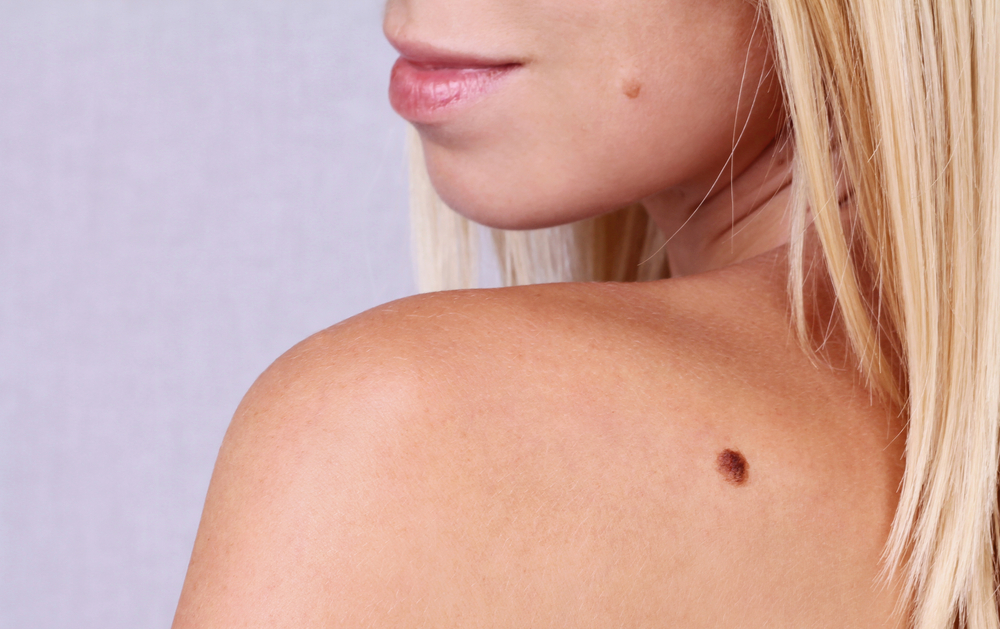- Moles, also known as nevi, are extremely common skin growths which typically first appear in childhood and young adulthood.
- Most moles are not dangerous, but some are. If your mole changes in shape or color you should consult with a dermatologist.
- There are multiple home remedies for removing moles. Some home remedies work, but they do have risks and may make matters worse.
For centuries people have peddled remedies, creams, serums and salves promising to make moles vanish. Today, the internet is filled with home remedies and “simple tricks” which supposedly remove moles overnight. While some home remedies for mole removal may be partially effective, home treatments also come with risks.
In most cases moles are just cosmetic annoyances, but other times they can represent genuine health concerns. Having rapidly growing or too many moles can represent an increased risk of skin cancer, colon cancer and other serious problems.
Keep in mind that professional mole removal by a dermatologist or plastic surgeon is relatively inexpensive and typically very fast. If you’re thinking about removing a mole, you should consider scheduling a consultation with a dermatologist to assess any potential health risks indicated by the mole. You should also consider the risks of removing a mole at home vs. the costs and advantages of professional mole removal.
What is a mole?
Moles are naturally occurring brown or black blemishes on the skin. They typically begin to appear between childhood and our early twenties. As we grow older, these blemishes often grow in size. They may become raised lumps and sprout one or more hairs. Moles appear darker than the surrounding skin because the melanocyte skin cells which give our skin its natural coloring are clumped tightly together within the mole.
On average, most of us have somewhere between 30 and 60 moles on our bodies. Some of us are blessed with fewer, while others have many more.
Moles come in many shapes and sizes, and may exist beneath the visible surface layer of the skin as well. Moles which extend deep into the dermis can be more difficult to remove.
There are two basic types of moles to be aware of: Congenital nevi and dysplastic nevi.
- Congenital nevi are moles that have been present since birth. They tend to be smaller and more regular in shape. About 1% of people are born with congenital nevi.
- Dysplastic nevi are moles that usually appear later in life. They are often larger in size and can have irregular (non round) shapes and variations of color within them.
Extremely irregular or mottled dysplastic nevi may be an indication of a more serious health condition like melanoma. If your mole fits the characteristics of a cancerous or precancerous mole (see below), seek the advice of a dermatologist before attempting home mole removal.
What are some home remedies for mole removal?
Over the years, many once popular home remedies for mole removal have come and gone. Many of these remedies were nothing more than popular myths, while others work with varying levels of effectiveness.
Most DIY remedies for mole removal tend to work best on small moles that are flat and level compared to the surrounding skin.
Generally speaking, most home remedies involve using a caustic substance (like lemon juice) to slowly burn away at the mole over the course of several days or weeks. While this approach may work, it can also damage the surrounding skin — even creating an indentation or “pit” in the surface.
If you have sensitive skin and experience redness, scabbing or swelling, stop using the home remedy and consult with your doctor.
We don’t recommend any specific home remedies as we believe the risks outweigh the rewards — but if you’re prepared to accept you could possibly be doing more harm than good, here are a few popular home remedies to get rid of moles:
- Apple Cider Vinegar: Apple cider vinegar is highly acidic and will eat away at the mole. Fans of this approach will soak a small piece of cotton or cotton ball with the vinegar and apply it to the mole for 8 or more hours a day, using duct tape or a band-aid to hold it in place. When applying apple cider vinegar, be careful not to allow it to make contact with the surrounding skin. People who champion this method claim the mole will start to fade within 4 to 5 days.
- Baking soda: Baking soda is a powerful alkali which can burn away the surface layer of skin. Fans of baking soda to remove skin moles typically make a thick paste by mixing the baking soda with either castor or vitamin E oil. The paste is then applied to the mole for four hours daily until the mole begins to fade. Use a cotton swab to put the baking soda paste directly on the mole and avoid the surrounding skin.
- Tea tree oil: Tea tree oil is a natural astringent with antimicrobial and antiviral properties. Whether it’s effective at mole removal is a matter of some debate, but in laboratory tests it has been shown to slow the spread of melanoma within the skin. Some people are allergic to tea tree oil so you should first test it on a small patch of skin and wait a few days to see if a rash develops before applying the oil to other areas.
- Lemon juice: Citric acid is a naturally occurring acid found in lemons and other fruits. It’s also a common ingredient of skin serums and bleaching agents. When applied to the skin, lemon juice has the dual effect of removing the surface layer of skin cells while naturally bleaching the skin.
- Grapefruit seed extract: Another natural astringent, grapefruit seed extract is a popular home remedy for mole removal. Apply this vitamin and antioxidant-rich solution 3 times a day and cover with a bandage until you see results.
Bear in mind that natural remedies and self-removal may hide or conceal moles which should be brought to the attention of a physician. If a mole is cancerous or precancerous, concealing it with home remedies may leave dangerous cancerous tissue behind, tissue which should have been excised completely by a dermatologist.
How can you tell if a mole is cancerous?
The vast majority of moles are non-cancerous. If you notice that a mole is changing in shape, size, or color, seek the advice of a dermatologist. You should also seek professional advice if your mole grows in height, or the surface begins to look uneven.
Of particular concern are moles which cause physical distress like itching or bleeding — or if they become tender and painful to the touch.
None of those things mean a mole is definitively “cancerous”, but they do indicate cause for concern. If you have a mole fitting this description you should watch it closely over time and alert your doctor to any changes.
Worried your mole might be cancerous? Ask a dermatologist for advice in our free forums.
Do mole removal creams work?
There are hundreds of products that claim to “clear moles away” and “make moles vanish”. Most of them work along the same lines as natural remedies — by bleaching or stripping away the top layer of skin. As with natural remedies, in some cases they may do more harm than good.
Creams that bleach moles won’t make a raised mole any less raised, but may act as concealers. In the event a mole represents a legitimate health-risk, simply concealing it may be a dangerous approach.
Other mole removal products have a high acid content and will gradually eat away at the surface of the skin. These types of creams can be dangerous as they may leave the skin pitted or cause scabs to form.
Professional Mole Removal
By far the most effective way to remove a mole is through surgery. While all surgical removals leave scars, the incisions are carefully sutured and the scarring minimized and controlled. Ideally, the scars will fade over time and blend to match the color of the surrounding skin. However, even with the best closure techniques, there is always the risk of noticeable scarring.
Surgical removal is also the only truly effective way to remove any subsurface growth which could pose future risks.
Typically, removed moles will be biopsied and sent to a lab to make sure they don’t represent a greater health risk like cancer.
Professional mole removal is easy and fast and carries fewer risks than many common home remedies. Click here to meet our medical review team who can suggest you the best way to get rid of your moles.









